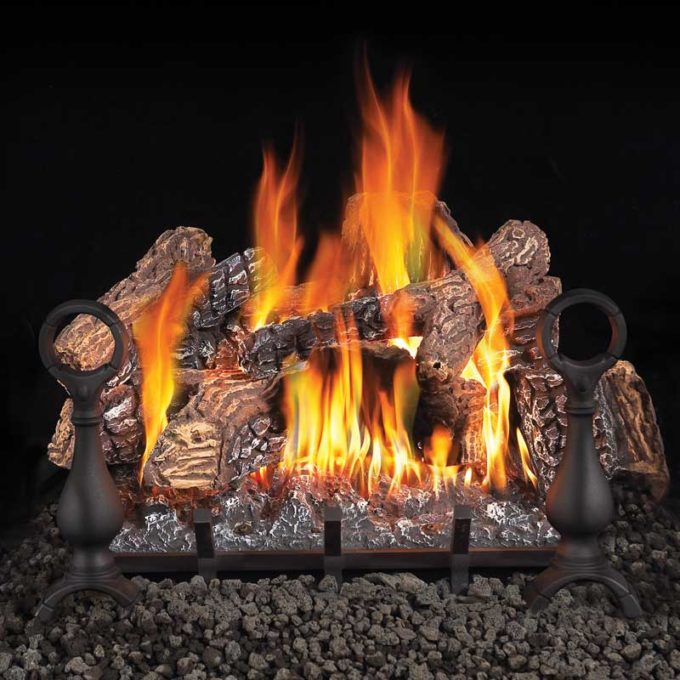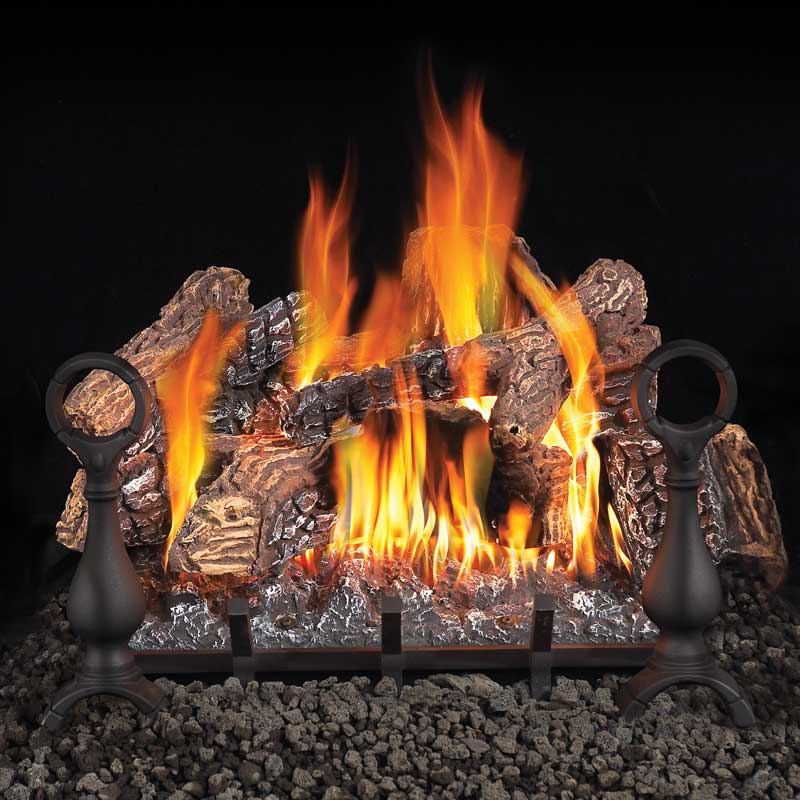A Beginner’s Guide to Fireplaces

Just like a heat pump or furnace, your fireplace needs attention and care. And, if you’ve never owned a home with a fireplace, it’s important to know what you’re getting yourself into.
In this comprehensive guide, we’ll cover everything a first-time fireplace owner should know, including the common components of a fireplace, steps for safely and effectively using one, and how to maintain one.
The Basic Components of a Fireplace

First, know that there are many different fireplace styles and designs that may come with their own unique features and components.
There are simply too many fireplace designs to list out. However, just to provide some examples, there are cast-iron wood-burning fireplace inserts, free-standing, wood-burning stoves with double-insulated pipes, fireplaces with built-in steel fireboxes and Octopus-style arm venting, and fireplaces with gas log sets.
It’s essential to familiarize yourself with how yours is designed and to read the manufacturer’s manual to know how it works.
Generally, most fireplaces will contain the following components:
- Firebox: This is where the fire burns and contains the wood (or gas).
- Hearth: The area in front of the firebox that serves as a protective barrier. It’s needed so embers and ash don’t fall inside your home directly onto combustible surfaces.
- Chimney: This is the passage where gases and smoke exit the home onto the outside.
- Flue: The inner lining of the chimney that directs contaminants (like smoke and gases) away from your home and prevents the formation of creosote, which is highly flammable and generally produced after burning wood. The flue also helps insulate the chimney walls. Some fireplaces may contain a single flue, while others may have multiple. The purpose of multiple flues is to prevent the backflow of smoke inside your home more effectively and reduce waste heat.
- Damper: Many traditional wood-burning fireplaces contain a damper, which controls airflow and prevents smoke backflow.
- Grate: The grate is located in the firebox and improves air circulation for better combustion and to help ash fall away from the burning wood.
- Ashpit: This is the area beneath the firebox that collects ash and is sometimes referred to as the fireplace floor.
- Access Panel: Access panels may be located on or near the firebox or at the bottom of the firebox in the ashpit. The access panel can lead to the basement or the back of the fireplace outside. The access panel provides an easy entry point for cleaning, inspecting, and repairing the fireplace, using the damper (if the fireplace has one), and/or accessing ventilation components. Some people with basement-style ashpits will typically not use their access panels because it may increase the risk of smoke from live ash dropping down into the basement.
Knowing Which Type of Wood to Burn
Did you know some types of wood aren’t good for your fireplace? It’s true! That’s why it’s important to be selective of the type of wood you’re burning in your fireplace.
Different types of wood burn at different temperatures and generate different amounts of creosote.
For example, Spruce pine, firs, and cypress are naturally sappy trees. You do not want to use these in your fireplace. Sappy trees produce higher levels of creosote during combustion, cause deposits in the flue, and produce more soot and smoke compared to hardwood.
Maples, hickory, oak, ash, and elm are all great choices of wood to use in your fireplace, and they’re commonly found in Michigan. These types of wood tend to burn at a higher BTU, which means they give off more heat and burn slower. They also leave behind less creosote.
Tips on Storing Wood
Knowing how to store your wood is just as important as knowing which type to burn.
Here are some important tips to follow:
- Always used cured wood. A tree must be cut down for over a year and stored in a dry place to be considered “cured.”
- Always keep your wood in your garage, shed, lean-to shed, basement, or any storage unit where the wood will remain cool and dry.
- Never put wet wood in your fireplace. When you put wet wood into your fireplace, the moisture and smoke together create a sappy, wet creosote, which cannot be professionally swept and must be removed with a special acid treatment.
How to Use Your Fireplace
Using a fireplace may seem obvious, but it’s normal not to know how to use one if you’ve never owned one!
Ensure the chimney and the flue are clean and that any flammable materials are away from the fireplace.
Next, make sure you have dry, cured wood, tinder, and kindling to start the fire.
Before you start the fire, ensure the damper or flue is open. Otherwise, you’ll enjoy a bunch of smoke filling your home. Your fireplace manual will have instructions on how to open the flue (or damper), but generally, there will be a knob that you have to turn or push. If you’re unsure whether the flue or damper is open, visually check by flashing a light up the chimney. If you can’t see the sky, it’s not open. You can also light a match and hold it near the fireplace. If the smoke goes up into the chimney, the flue is open. If it’s not, the flue is either closed or obstructed.
Once the damper or flue is open, you can start burning wood. Never leave a fire unattended. We recommend you place a screen in front of the fireplace to prevent sparks from entering your home and touching combustible objects. Additionally, you do not want to overwork your firebox. Every firebox has a limit on how much wood you can burn at one time (consult the manufacturer’s manual). If you overwork your firebox, the smoke chamber will let you know because smoke will billow from the fireplace. Overworking the firebox can also cause damage to the firebrick and refractory mortar joints.
When you’re done with the fireplace, always fully extinguish the fire, clean out the ashes, and close the damper to prevent drafts.
Tips on Starting a Good Fire
To start, you’ll have to have a decent amount of patience and the nurturing of a mother. A fire starts with tinder, kindling, and wood (dry and cured). Be sure you have a good base of tinder, which could be paper or dry bark. Then, slowly add in your kindling before adding one log. You want to concentrate on burning that one log before adding more.
We also recommend purchasing a bellow, a hand tool that looks like a bag with handles. You can use the bellow to blow air directly onto the fire, which adds extra oxygen to the flame, allowing the fire to burn longer.
Service & Maintenance for a Fireplace
It’s critical that you have your fireplace serviced annually.
Annual service, which usually involves a comprehensive inspection and cleaning, helps to remove creosote. When creosote builds up in your fireplace, it poses a risk to you and your family and could potentially damage your fireplace.
Annual maintenance also helps to remove critters that may be living in your fireplace.
If the fireplace has sat dormant for many years, it’s highly likely that there will be spiders (yes, spiders!). Spiders love fireplaces because they are dark, deep, and perfect for hunting common house bugs, like flies. Spiders aren’t just creepy—they can cause your fireplace to perform poorly, too. Typically, a fireplace infested with spiders will result in smoke billowing from the fireplace.
So, we can’t overstate this enough—please get your fireplace inspected annually, even if you don’t use it frequently!
What Happens During a Professional Inspection
We can’t speak for what other companies do, but at Art of Stone, we use two technicians for our sweeps and inspections.
One technician will be up on the roof while the other is inside. The technician on the roof inspects the crown, chimney cap, and flue tiles while running his chimney brooms. The technician inside inspects the smoke chamber, damper door, and firebrick to look for cracks or compromised areas.
At the end of the inspection, our technicians will report any cracks in the flue tile, wash collar, or firebrick and issues with the chimney cap or damper door. They will also report missing grates, doors, screens, and hand tools and determine if your smoke chamber needs to be parged. If your smoke chamber was parged, our technicians would also report any cracks in the refractory mortar (sometimes called parging). If there are cracks in the parging, they need to be professionally repaired.
Keeping up with annual maintenance ultimately gives you peace of mind, knowing your fireplace is safe to use.
Additional Maintenance Recommendation: Get a Chimney Cap!
Our technicians at Art of Stone will notify you if your chimney does not have a cap. A chimney cap improves the functionality of the fireplace.
The top plate of the cap stops down-pressure from high winds that cause smoke to billow from the fireplace. The cap also prevents rain from washing down your flue tiles. When rain washes down the chimney, it can mix with creosote to create sulfuric acid, which eats away at the flue tiles, causing the chimney and fireplace interior to crumble. Sulfuric acid will also rust out your damper door, causing unwanted drafts.
Additionally, the screen on a chimney cap acts as a respirator, keeping live ash from escaping your chimney. The screen also prevents animals from nesting inside your chimney.
Request Your Annual Inspection Today
We hope this article helped you understand how to safely and effectively use and maintain your fireplace.
Please contact us today with any questions about your fireplace or to schedule your annual inspection and cleaning!
